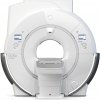At RSNA, GE Healthcare unveiled its new SIGNA Pioneer 3.0 Tesla MRI system that comes with a revolutionary new imaging technique called MAGiC, which according to GE may reduce imaging times by up to two-thirds. In addition, the scanner features an enhanced version of GE’s SilentScan technology, which makes many scans almost completely silent and is now available for more than just neuro scans. Both the SIGNA Pioneer scanner and the MAGiC technology are pending FDA approval and have not yet received the CE mark.
MAGiC is an MR technique that allows for the acquisition of multiple image contrasts at the same time. In a single scan T1, T2, STIR, T1 FLAIR, T2 FLAIR and PD weighted images can be acquired. On top of that, contrast of images can even be changed afterwards as you can retrospectively change acquisition parameters such as TR, TE and TI and see the results. Although GE is reluctant to reveal much about the details underlying MAGiC, it is the result of a collaboration with SyntheticMR AB (Linköping, Sweden), and therefore likely building upon that company’s SyMRI technology. SyMRI uses a multislice, multiecho, and multi delay acquisition, and from this single scan it quantifies absolute T1 relaxation, T2 relaxation, and proton density (PD) values, as well as the amplitude of the local radio frequency B1 field. Some papers linked at SyntheticMR AB’s website describe the technique in more detail, and below we have included a video showcasing the technology. In addition to shorter scans, this may also enable easier and more accurate quantification of the specific tissue characteristics.
SilentScan was first introduced two years ago at RSNA, and last year it was expanded to a full neuro-package. The enhanced SilentScan feature enables SilentScan to be used for musculoskeletal and spine imaging in addition to a complete neuro exam that now also includes diffusion weighted imaging. SilentScan reduces scan noise levels from around 110 decibels to just three decibels above ambient noise for most head exams, a major improvement for patient comfort.
The SIGNA Pioneer also features technology called Total Digital Imaging that enables improved image quality and increases signal to noise ratio by up to 25 percent. This is composed of three independent technologies: the RF signal received by each RF channel is directly digitized, the digital signal from every surface coil element is combined with the signal from the integrated RF body coil, and an RF coil design with intelligent micro electro-mechanical switches (MEMS) that support ultra-fast coil switching. This last feature enables future expansion of zero echo time imaging capabilities, which may visualise structures such as cortical bone, ligaments, and tendons, which have little to no signal with conventional MRI sequences.
Source:GE Healthcare
GE SIGNA Pioneer with MAGiC Reduces MRI Acquisition Time by Two-Thirds

